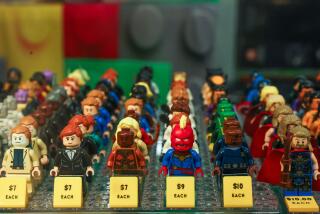Wartime Renews the Sales Action for GI Joe
- Share via
In times like these, America embraces a hero--even if he’s only 12 inches tall.
Makers of GI Joe, the action figure whose career spans a venerable 37 years, say sales are booming, thanks in part to a resurgent interest in the military and old-fashioned heroism in the wake of Sept. 11.
It’s an impressive comeback for a toy that had become obsolete, at least in its original foot-tall form, for more than a decade, and only returned full time to toy store shelves seven years ago.
“The military has become interesting to kids again,” says Derryl DePriest, who directs GI Joe marketing for Hasbro Inc. “If anything, recent events reinforce those core values that GI Joe symbolizes--honor, duty and commitment.”
Hasbro officials are not willing to share exact sales figures, but will admit that sales of the toy have done “very well” since the terrorist attacks.
Toy industry observers say the doll’s surprising comeback started long before Sept. 11, however, which may say as much about GI Joe’s ability to adapt to his times as it does about current public tastes.
“The kids want heroes, and right now [the country has] clear heroes: They wear olive drab, and firemen’s hats and flak jackets,” says John Michlig, author of “The Complete Story of America’s Favorite Man of Action” (Chronicle Books, 1998).
GI Joe came dressed strictly in olive drab in 1964, when he was first unveiled by Hasbro. Michlig describes the toy as the company’s answer to Barbie, rival toy maker Mattel’s hugely popular doll. With his articulated limbs and elaborate wardrobe and accessories, he was more or less a copy of Ken, if Barbie’s boyfriend had enlisted in the Army. Fearful that he might be perceived as a girl’s doll, Hasbro even put a scar on GI Joe’s right cheek, and company salesmen were told to describe the product only as an “action figure.”
“Hey, I wouldn’t have had my son playing with a doll or dressing a doll,” recalls Sam Speers, 75, of Sarasota, Fla., who helped create GI Joe as Hasbro’s director of product development in the 1960s. “But once we put him in the military, then it was all right. It changed my mind entirely.”
After modest sales initially, GI Joe’s career took off, thanks to some effective television advertising. The toy’s career threatened to unravel a few years later, when concerns about the Vietnam War sharply lowered the public’s opinion of the military. Rhode Island-based Hasbro responded by making GI Joe an adventurer rather than a military man. His wardrobe switched from camouflage and helmets to space suits and explorer jackets.
But things worsened by the late ‘70s, when the post-Watergate generation seemed more attuned to anti-heroes. It didn’t help that OPEC’s oil embargo raised the price of plastic. Hasbro officials discontinued the 12-inch version in 1978.
“Kids lost interest in GI Joe,” says Vincent Santelmo, author of “The Complete Encyclopedia to GI Joe” (Krause Publications, 2001). “It was a time of long hair, tattoos and chicks. GI Joe didn’t fit in.”
But GI Joe wasn’t ready to turn in his plastic dog tags. In 1982, Hasbro started making a 33/4-inch model--the same size as the highly successful Star Wars action figures. Sales took off again, boosted by tie-ins to a comic book and an animated TV series that was little more than a 30-minute advertisement for the line of GI Joe figures. But even that success eventually petered out, and the miniature GI Joes were discontinued in the mid-’90s.
Hasbro’s decision to revive the full-size GI Joe in 1994 was aimed largely at the growing legions of GI Joe collectors, mostly middle-age men. Hasbro hadn’t expected youngsters to buy into the toy, but it turned out to be a hit.
Today, the GI Joe line is again extensive, if still not quite like the original. Where the original GI Joe cost $4, today’s version retails for $10 to $30, with some limited-edition models selling for as much as $150.
Hasbro officials haven’t lost their touch for sensing the public’s mood. The week of Sept. 11, the company was in the process of shipping out a new model--a search-and-rescue firefighter--now selling out in most stores. “It was a coincidence. We haven’t changed our strategy [of marketing] in light of recent events,” says DePriest, who plans to revive the smaller GI Joes next year.
Still, society has changed in 37 years, and even GI Joe collectors suspect many parents will be reluctant to buy a toy with a close association to guns and violence. Santelmo, who has written five hobbyist books about GI Joe, , has misgivings about his own two children playing with armed soldiers.
“Real life and the horrors of war are not a pleasant thing,” says Santelmo, 40. “GI stands alone for what he represents as an action figure. He’s also just a toy.”
More to Read
The biggest entertainment stories
Get our big stories about Hollywood, film, television, music, arts, culture and more right in your inbox as soon as they publish.
You may occasionally receive promotional content from the Los Angeles Times.










